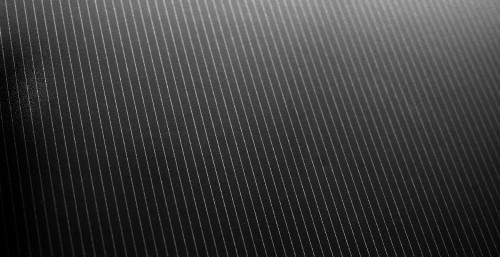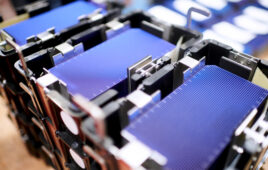The general public may be most familiar with crystalline silicon PV panels, but thin-film manufacturers are trying their best to make a dent in the market. First Solar has established its dominance in the cadmium telluride (CdTe) arena, but CIGS thin-film (made of copper, indium, gallium and selenide) manufacturers think they could be just as competitive with better equipment and production.

A close-up view of a Stion CIGS thin-film solar module
Unfortunately, many developers are hesitant to bank on CIGS, mostly because of big names loudly going bankrupt or closing (Solyndra, Nanosolar, MiaSolé and most recently TSMC Solar). TSMC, which ceased manufacturing this past summer, blamed its late entry into the market and lack of economies of scale as reasoning for shuttering its doors.
A recently released white paper from major CIGS players (Solar Frontier, Hanergy, Solopower, Stion, Siva Power and more) pushes the message that the lesser known thin-film solar technology still holds great potential. CIGS, already featuring a solid 16.5% production module efficiency, can be combined with other solar cells to enable efficiency values beyond 30%, the white paper claims. CIGS modules’ low temperature coefficient and high efficiency under low light conditions produces high energy yields with a low levelized cost of electricity.
Markus Beck, CTO of Siva Power, said it was easier for silicon-based PV modules to establish market dominance because they could borrow equipment and ideas from the mature semiconductor industry. Thin-film had to develop everything—tools, equipment and supply chains. Luckily, the venture capitalists that funded First Solar and its CdTe predecessors had the foresight to know developing a new product would take time. CIGS didn’t have that same luxury.
“CIGS came out of academic institutes. They know what they’re doing but they never had an operational focus, a manufacturing focus,” Beck said. Many of those investing into CIGS technology wanted to differentiate and solve problems that didn’t exist, he said. These companies went too big, too hard, too fast. Of course they went bankrupt.
“None of it worked,” Beck said. “It looks like a lot of money was wasted. There was this irrational hope that they would get huge returns out of these companies. Then they didn’t want to put money into this technology again.”
What’s come out of the Solyndra-sized failures in CIGS is extensive R&D. Now many companies feel they have found the right processes, the right applications, the right makeup to be successful. The monetary investment just has to return.

A Stion CIGS thin-film solar module
“There is no money going into CIGS and all this learning, this technology, this supply chain … we’re at risk of losing,” Beck said. “CIGS now is better positioned than any technology because it has all of these advantages: low-cost structure, few process steps, we have the supply chain, and we can scale. There is a tremendous opportunity. I’m not saying First Solar isn’t going to continue to prosper, nor am I saying that silicon is going to go away overnight. CIGS has proven to be reliable, durable. There is room for another technology to grow in the market space.”
Kannan Ramanathan, senior fellow at Stion, agreed that CIGS will find its place in the market.
“For CIGS—or, for that matter, PV—to be a dominant force, reality needs to set in,” he said. “The industry will eventually ‘right-size.’ The current scenario is artificial and not sustainable. There is not much investment in new plants. Climate change and the escalation of unnatural climatic events will create a demand for distributed power. The future is predictable in that sense and there will be demand for made-in-the-USA PV. CIGS has a great role to play.”
Rather than battling with thin-film cousin CdTe, Beck thinks CIGS could make a larger dent in the silicon market.
“When I commute to work, I see on the road a lot of very average cars. I see very few Bugattis and Maybachs and Ferraris,” he said. “I think the same is true for photovoltaics. SunPower and SANYO can only sell so many of these premium products. The bulk of the market is going to be the lower cost, adequate, 15% [efficient] module. We don’t think we’ll be stuck at 15%, but the point is you can do 18% [thin-film] module at below the costs of an 18% silicon module. We would argue there is a business case to be made.”





This article is now TWO years old. CIGS solar panels are now being produced & sold as an option on all nüCamp Teardrop & truck camper units by SunFlare: https://www.sunflaresolar.com/
What a a nice little bit of dancing: “CIGS came out of academic institutes. They know what they’re doing but they never had an operational focus, a manufacturing focus”
Sorry, if your modules don’t last before deteriorating, are not reproducing adequately, and are not made with the advertised efficiency, it’s not an “operations” problem. It means you did not design the process very well.
Are efficiencies reproducible?
So much talk.
So few sells.
It’s showtime folks. Stop marketing and start selling competitive CIGS modules and many will be there to support and buy TF solutions. We have read the standard TF story for the past 5 years and have yet to see a sustainable TF solution. The exception are ‘closed-market’ First Solar modules that are not accessible to the broader solar development market unless the project is a First Solar turn-key.
Continuing discussion about TF theoretical efficiency and actual efficiency is a distraction from the business model approach to solar development. When TF modules offer a competitive solution these modules would be commanding serious attention of the solar development community and increasing market share.
I would like to recommend TF modules for large projects (500kW+) for certain applications but one constraint goes beyond price/kWp, efficiency and warranty: TF nameplate module dimensions require more area per MWp than c-Si arrays of similar power yield.
Bob, most EPCs or developers I come across in competition still assume TF is either defunct as a commercial solution or in its infancy. You’re absolutely right, “it’s showtime”, and for the past couple years we have been dominating our competition (the largest regional and national players) in the 250kW-5MW+ commercial space. True, we don’t waste much money on Marketing at Stion for everyone nationwide to hear about us, but you and I are probably aligned on that strategy – “stop marketing and start selling…”.
Whether it’s an RFP or direct commercial competitive bid, we have an unusually high win rate. I doubt it’s the same for everyone else in TF (in my case CIGS), but our vertical integration, project cost parity, superior performance, lack of degradation, unique aesthetics, and a Made-in-America value proposition makes for an unbeatable mix.
I’m not in module sales, but on the downstream Projects & Systems side (EPC/Development), so I am in charge of turn-key projects and BD with a select few developer/strategically important partners and see this on a daily basis.
Actually, I prefer to be the heavily differentiated sleeper hit in this commoditized industry; no one sees me or my partners coming. When I can provide more power in a smaller space (contrary to your mention of inferior power yield), and do it with an overall superior value proposition… I win.
In paragraph 3, you reference a white paper by Solar Frontier et.al. Can you please provide a link to this? Thanks.
You can find it here: https://www.solarpowerworldonline.com/wp-content/uploads/2016/01/CIGS-WhitePaper.pdf